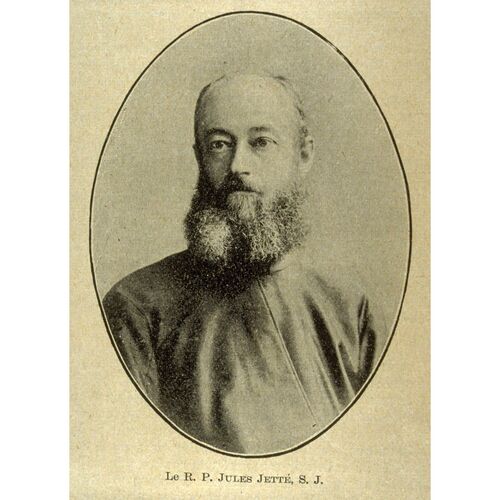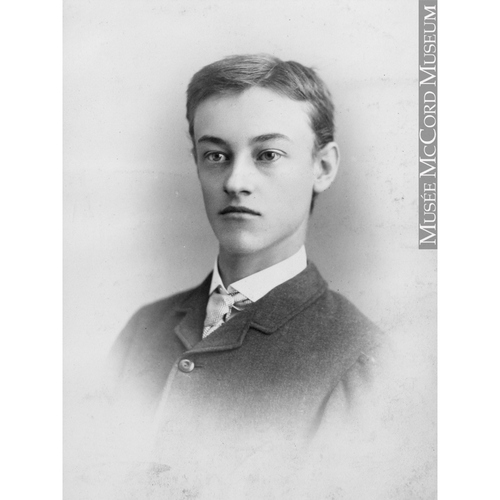JETTÉ, JULES, professor, Jesuit missionary, ethnographer, and specialist in the Koyukon language; b. 30 Sept. 1864 in Montreal, son of Louis-Amable Jetté* and Berthilde Laflamme; d. 4 Feb. 1927 in Akulurak, Alaska.
Jules Jetté was born into a well-to-do Montreal family. His mother was the daughter of a rich merchant of that city. His father, who was a lawyer, became a leader of the young Liberals in the Parti National. After spending a few years in Ottawa as an mp, he was appointed to the bench and he later became lieutenant governor of Quebec. Jules attended the Petit Séminaire de Montréal from 1874 to 1880, and then studied at the Collège Sainte-Marie, where he spent two years in the Philosophy program but did not finish it. In 1882 he entered the Society of Jesus. He began his noviciate on 1 September in Sault-au-Récollet (Montreal) and finished it in September 1884, when he took his final vows. A long period of intellectual training followed, which he completed in 1898, despite the difficulties caused by migraines and other health problems. Jetté had applied himself initially to studying the natural sciences, numerous languages (Latin, Greek, Italian, Spanish, English), and French literature, in all of which he was successful. After teaching a few courses in mathematics at the Scolasticat de l’Immaculée-Conception in Montreal in his spare time, and serving as science monitor at the Collège Sainte-Marie from 1885 to 1887, he left Sault-au-Récollet in the summer of 1888 and went to the Université d’Angers, in France, seeking a degree in mathematics. Although he had some difficulty coping with this first separation from his native land, the experience whetted his curiosity about ethnography. He eventually abandoned mathematics for metaphysics, but failed the examination for his degree and returned to Canada in September 1890. After a brief stay at the scholasticate, he was sent to the Collège de Saint-Boniface in Manitoba, where he taught mathematics and science until 1892. In the course of these years he became firmly convinced of his missionary vocation, and he prepared for it by accompanying students when they went out on snowshoes and by taking an interest in the northern missions. On his return to the Scolasticat de l’Immaculée-Conception he completed the Philosophy program and took courses in theology.
In May 1896 Jetté was ordained to the priesthood by Archbishop Édouard-Charles Fabre* in Le Gesù, the church adjoining the Collège Sainte-Marie. As a result of increasingly severe migraines he was, however, excused from the final year of theology. In the summer of 1896 he served as bursar at the noviciate of the Society of Jesus (Maison Saint-Joseph) in Sault-au-Récollet, but in 1897 a visit by Father John Baptiste René, the prefect apostolic of the Alaska mission, prompted him to ask that he be sent there as a missionary. Rome granted his request on 18 May 1898 and Father François-Xavier Renaud, the superior of the Jesuits in Canada at the time, notified him of his appointment.
Father Jetté’s stay in Alaska would stretch over nearly 30 years, from 1898 to 1927, with a brief interlude in Canada. During his first journey, which would last until 1903, he had various learning experiences. He went first to San Francisco, which he left on 13 June 1898. After two weeks at sea he stopped at St Michael Mission, north of the Yukon River estuary in Alaska, and spent three months there – long enough to build a boat. He then travelled up the Yukon as far as the village of Nulato, north of Holy Cross, where Father Charles John Seghers* had been murdered on 28 Nov. 1886, while founding a mission. By the end of September he was beginning his first pastoral rounds. On foot, by sled, or by boat, he covered enormous distances to visit the aboriginal camps scattered across the interior of the country and on the banks of the river. He continued the missionary work using his predecessors’ methods, which sought to gain the confidence of the natives principally through the education of the children and through singing lessons. Jetté’s regular correspondence with his mother and his articles for the Jesuit periodical Woodstock Letters (Woodstock, Md) show how well he had adapted to local traditions and to the diet of the indigenous people. He even learned their language, Koyukon. Semi-nomadic hunters belonging to the Athapaskan language group, these natives practised shamanism, which the missionary, with the ethnocentrism common to his time, considered full of superstition.
Jetté returned to Canada in July 1903. He travelled by train from Seattle, Wash., to Montreal, and even journeyed as far as Quebec to visit his family. He then went back to the Collège de Saint-Boniface for a year’s rest. An indefatigable worker, he again taught mathematics there, while finishing a collection of prayers, songs, and devotions in Koyukon, which he published in Winnipeg in 1904 under the title Yoyit rokanaga: nulator roka do-daletloye.
Jetté’s second trip to Alaska – one from which he would not return to Canada – was more eventful. After leaving Seattle in the summer of 1904, he stopped over at Nulato and then continued to Fairbanks the following year. He found his work there very difficult because of the severe ravages caused by alcohol among the parishioners. Father Jetté succeeded in converting many Protestants to Catholicism at Kokrines, to which he was assigned from 1907 to 1913, and in the surrounding villages, among them Mouse Point. However, the opening of a mining centre in the Ruby region around 1908 marked the beginning of a frustrating period that lasted until 1913, during which the missionary waged a bitter struggle against the whisky traders.
The submission of a paper to the 15th International Congress of Americanists, held at Quebec in 1906, marked the beginning of Jetté’s career as an ethnographer. He later published a number of articles on the social organization and religious traditions of the Koyukons in such periodicals as the Journal (London) of the Royal Anthropological Institute of Great Britain and Ireland in 1907, 1908, and 1909, Man (London) in the same years, and Anthropos (Vienna) in 1911 and 1913. He was also the author of a huge dictionary of some 30,000 words, which remained unpublished until 2000. Jetté made a considerable contribution to ethnography that was of excellent quality, to judge by the praise of anthropologists such as Frederica De Laguna and linguists such as Michael E. Krauss.
In May 1913, following the sudden departure of Father Crispino Rossi, Jetté was recalled to Nulato, where he acted as superior for a year. From 1914 to 1922 he lived in the Tanana region, a bit farther north on the Yukon River. In addition to his pastoral work among the aboriginals and whites, he pursued his studies in linguistics. In 1916 he did substitute work on a number of occasions in Ruby and Kokrines, but his missionary activities were suddenly interrupted in 1922 by a serious hernia. Treated at the Fairbanks hospital, he was sent to Seattle to convalesce in October 1923. Despite these difficulties, he used his time to teach French in a college and to begin writing a history of Christian missionary work in Alaska from 1741 to 1877. In the summer of 1925 he obtained permission to return there, and he served as chaplain to the Fairbanks hospital. In July 1926 he took up residence at the mission in Holy Cross, where he was asked to preach at the nuns’ annual retreat. Having a talent for ethnology and for learning languages, the missionary set out on a journey through the region. In mid July he was in Akulurak, another Jesuit mission looking out over the Bering Sea. He spent several weeks there, along with Father Martin Lonneux, cooking and maintaining the mission, which was attended mainly by Yupiks (Alaskan Inuit). Their language became a new passion for Father Jetté, but on 4 Feb. 1927 he died of exhaustion.
Although not widely known outside Alaska, Jules Jetté remains a missionary to be reckoned with in the history of Jesuit evangelization in that region. His linguistic and ethnological contribution is still indispensable for understanding the oral tradition of the Koyukons. Persistent, meticulous, and discerning in his work – a man ahead of his time – Jetté was a linguist who succeeded in highlighting regional variations and linking language and culture.
Jules Jetté’s dictionary was completed by Eliza Jones and published as Koyukon Athabaskan dictionary (Fairbanks, Alaska, 2000). ANQ-M, CE601-S51, 1er oct. 1864. Arch. de la Compagnie de Jésus, Prov. du Canada Français (Saint-Jérôme, Qué.), BO-27 (Théophile Hudon); BO-44 (Jules Jetté). Le Devoir, 3 mars 1927. R. C. Carriker et al., Guide to the microfilm edition of the Oregon Province archives of the Society of Jesus Indian language collection: the Alaska native languages (Spokane, Wash., 1976). Antonio Dragon, Enseveli dans les neiges: le père Jules Jetté (Montréal, [1951]). L. L. Renner, “Julius Jetté: distinguished scholar in Alaska,” Alaska Journal (Anchorage, Alaska), 5 (1975): 239-47. L. L. Renner and D. J. Ray, Pioneer missionary to the Bering Strait Eskimos: Bellarmine Lafortune, S.J. (Portland, Oreg., 1979). Angel Santos, Jesuitas en el Polo Norte: la mision de Alaska (Madrid, 1943). George St. Hilaire, “Julius Jetté, S.J.: language and ethnology scholar of the Yukon,” Nouvelle Rev. de science missionnaire (Beckenried, Switzerland), 14 (1958): 241-52.
Cite This Article
Frédéric Laugrand, “JETTÉ, JULES,” in Dictionary of Canadian Biography, vol. 15, University of Toronto/Université Laval, 2003–, accessed December 31, 2025, https://www.biographi.ca/en/bio/jette_jules_15E.html.
The citation above shows the format for footnotes and endnotes according to the Chicago manual of style (16th edition). Information to be used in other citation formats:
| Permalink: | https://www.biographi.ca/en/bio/jette_jules_15E.html |
| Author of Article: | Frédéric Laugrand |
| Title of Article: | JETTÉ, JULES |
| Publication Name: | Dictionary of Canadian Biography, vol. 15 |
| Publisher: | University of Toronto/Université Laval |
| Year of publication: | 2005 |
| Year of revision: | 2005 |
| Access Date: | December 31, 2025 |


![Le R. P. Jules Jetté, S. J. [image fixe] Original title: Le R. P. Jules Jetté, S. J. [image fixe]](/bioimages/w600.7328.jpg)


